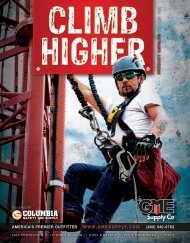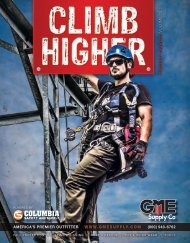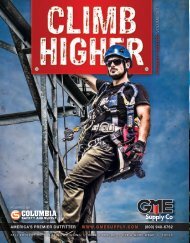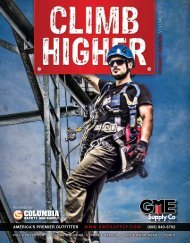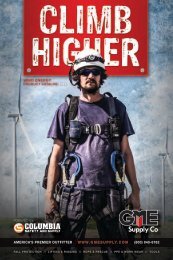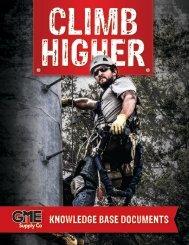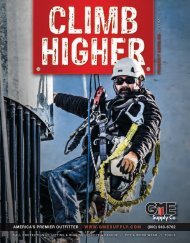GME Supply Product Catalog Version 18.1
GME Supply is North America's premier outfitter of fall protection, safety equipment, and gear for at-height workers, industry, and construction.
GME Supply is North America's premier outfitter of fall protection, safety equipment, and gear for at-height workers, industry, and construction.
You also want an ePaper? Increase the reach of your titles
YUMPU automatically turns print PDFs into web optimized ePapers that Google loves.
HOW TO TO PROPERLY DON, ADJUST, AND INSPECT A FULL BODY HARNESS<br />
FULL BODY HARNESS 101<br />
donning THE HARnESS<br />
1<br />
Untangle and VisUally<br />
CheCk harness<br />
Grab the harness by the dorsal D-ring<br />
and follow the chest strap to untangle.<br />
Closely look over the harness webbing<br />
for abrasion, the hardware for excessive<br />
wear, and the impact indicators to<br />
ensure it hasn’t been in a fall.<br />
2<br />
don the harness<br />
Put your arms through the<br />
shoulder straps, like a jacket.<br />
Don’t secure the chest strap yet.<br />
3<br />
adjUst From the<br />
Bottom Up<br />
The sub pelvic strap should rest just<br />
below your buttocks. Raise or lower this<br />
using torso adjusters, usually above<br />
the waist belt.<br />
4<br />
ConneCt & adjUst<br />
leg straps<br />
These should be snug, but not overly<br />
tight. You should be able to slide 2 or 3<br />
fingers between your leg and the strap.<br />
5<br />
ConneCt & adjUst Chest<br />
strap & waist Belt<br />
Waist belt should be snug, but not too tight<br />
or too loose. The chest strap should rest<br />
directly across your chest cavity. Not too<br />
high, not too low, but right in the sweet spot<br />
to keep you safe.<br />
TYPES oF ConnECToRS<br />
dorsal ConneCtion<br />
This D-Ring is found on all ANSI harnesses.<br />
It’s used for fall arrest and should be placed<br />
directly between the shoulder blades.<br />
Chest strap<br />
Tower harnesses have another D-Ring here.<br />
It’s the only other connection point which can<br />
be used for fall arrest, like on a cable climb<br />
system. Unlike the Dorsal D, fall distance must<br />
be limited to 2 feet or less.<br />
tongUe BUCkles<br />
Easy operation, cannot slip once<br />
in position.<br />
QUiCk-ConneCt<br />
Easiest operation, but can<br />
occastionally require readjustment.<br />
pass-thrU/mating<br />
Cheapest options, hardest to use<br />
and adjust properly.<br />
work positioning<br />
Side D-rings are used for work positioning.<br />
Never fall arrest.<br />
inSPECTing THE HARnESS<br />
Visually inspect these key areas of the harness every time, prior to beginning work. If you find any of these<br />
problems, take the harness out of service.<br />
weBBing<br />
Cuts, tears, excess abrasion, holes, discoloration, UV damage, heat damage, welding slag, chemical<br />
damage, hard spots<br />
stitChing<br />
Damaged stitching, broken thread, pulls and loose stitches, missing sections<br />
d-rings, hardware, & BUCkles<br />
Deformity, corrosion and rust, major nicks and dings, excess wear, proper operation<br />
impaCt indiCators<br />
Deployed impact indicators, broken D-ring plates, deformed grommets<br />
laBels<br />
Manufacturer, date of manufacture, inspection log, model, series, warnings<br />
seat sling<br />
A seat is a common feature on tower harnesses,<br />
and if you’re working in suspension, you’ll<br />
be glad you have one. Look for features like<br />
additional tool loops or aluminum reinforcement.<br />
D-Rings can be connected using a spreader bar.<br />
PURCHASE THE<br />
19” x 27” POSTER FOR<br />
$14.95<br />
PART # 2201











